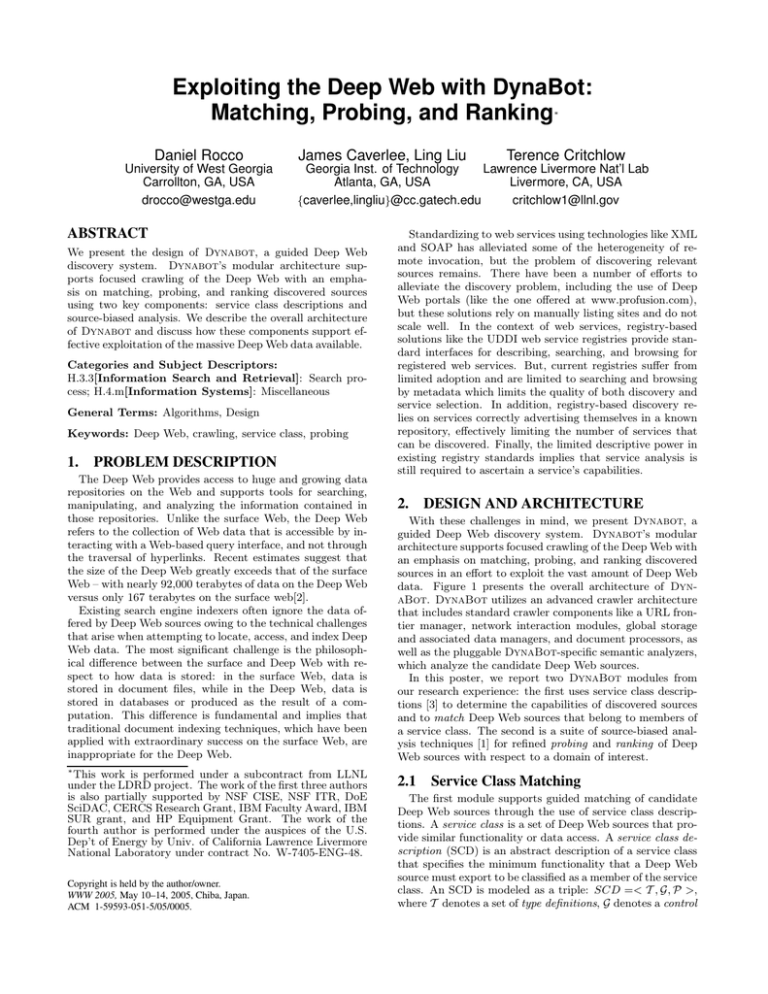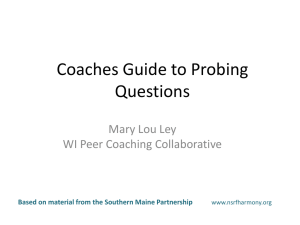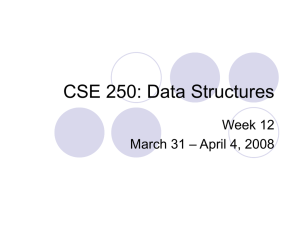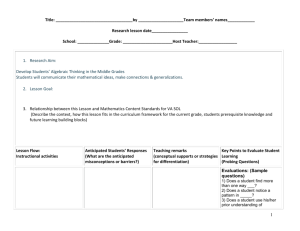Exploiting the Deep Web with DynaBot: Matching, Probing, and Ranking Daniel Rocco
advertisement

Exploiting the Deep Web with DynaBot:
Matching, Probing, and Ranking
∗
Daniel Rocco
University of West Georgia
Carrollton, GA, USA
drocco@westga.edu
James Caverlee, Ling Liu
ABSTRACT
We present the design of Dynabot, a guided Deep Web
discovery system. Dynabot’s modular architecture supports focused crawling of the Deep Web with an emphasis on matching, probing, and ranking discovered sources
using two key components: service class descriptions and
source-biased analysis. We describe the overall architecture
of Dynabot and discuss how these components support effective exploitation of the massive Deep Web data available.
Categories and Subject Descriptors:
H.3.3[Information Search and Retrieval]: Search process; H.4.m[Information Systems]: Miscellaneous
General Terms: Algorithms, Design
Keywords: Deep Web, crawling, service class, probing
1.
PROBLEM DESCRIPTION
The Deep Web provides access to huge and growing data
repositories on the Web and supports tools for searching,
manipulating, and analyzing the information contained in
those repositories. Unlike the surface Web, the Deep Web
refers to the collection of Web data that is accessible by interacting with a Web-based query interface, and not through
the traversal of hyperlinks. Recent estimates suggest that
the size of the Deep Web greatly exceeds that of the surface
Web – with nearly 92,000 terabytes of data on the Deep Web
versus only 167 terabytes on the surface web[2].
Existing search engine indexers often ignore the data offered by Deep Web sources owing to the technical challenges
that arise when attempting to locate, access, and index Deep
Web data. The most significant challenge is the philosophical difference between the surface and Deep Web with respect to how data is stored: in the surface Web, data is
stored in document files, while in the Deep Web, data is
stored in databases or produced as the result of a computation. This difference is fundamental and implies that
traditional document indexing techniques, which have been
applied with extraordinary success on the surface Web, are
inappropriate for the Deep Web.
∗
This work is performed under a subcontract from LLNL
under the LDRD project. The work of the first three authors
is also partially supported by NSF CISE, NSF ITR, DoE
SciDAC, CERCS Research Grant, IBM Faculty Award, IBM
SUR grant, and HP Equipment Grant. The work of the
fourth author is performed under the auspices of the U.S.
Dep’t of Energy by Univ. of California Lawrence Livermore
National Laboratory under contract No. W-7405-ENG-48.
Copyright is held by the author/owner.
WWW 2005, May 10–14, 2005, Chiba, Japan.
ACM 1-59593-051-5/05/0005.
Terence Critchlow
Georgia Inst. of Technology
Lawrence Livermore Nat’l Lab
Atlanta, GA, USA
Livermore, CA, USA
{caverlee,lingliu}@cc.gatech.edu
critchlow1@llnl.gov
Standardizing to web services using technologies like XML
and SOAP has alleviated some of the heterogeneity of remote invocation, but the problem of discovering relevant
sources remains. There have been a number of efforts to
alleviate the discovery problem, including the use of Deep
Web portals (like the one offered at www.profusion.com),
but these solutions rely on manually listing sites and do not
scale well. In the context of web services, registry-based
solutions like the UDDI web service registries provide standard interfaces for describing, searching, and browsing for
registered web services. But, current registries suffer from
limited adoption and are limited to searching and browsing
by metadata which limits the quality of both discovery and
service selection. In addition, registry-based discovery relies on services correctly advertising themselves in a known
repository, effectively limiting the number of services that
can be discovered. Finally, the limited descriptive power in
existing registry standards implies that service analysis is
still required to ascertain a service’s capabilities.
2. DESIGN AND ARCHITECTURE
With these challenges in mind, we present Dynabot, a
guided Deep Web discovery system. Dynabot’s modular
architecture supports focused crawling of the Deep Web with
an emphasis on matching, probing, and ranking discovered
sources in an effort to exploit the vast amount of Deep Web
data. Figure 1 presents the overall architecture of DynaBot. DynaBot utilizes an advanced crawler architecture
that includes standard crawler components like a URL frontier manager, network interaction modules, global storage
and associated data managers, and document processors, as
well as the pluggable DynaBot-specific semantic analyzers,
which analyze the candidate Deep Web sources.
In this poster, we report two DynaBot modules from
our research experience: the first uses service class descriptions [3] to determine the capabilities of discovered sources
and to match Deep Web sources that belong to members of
a service class. The second is a suite of source-biased analysis techniques [1] for refined probing and ranking of Deep
Web sources with respect to a domain of interest.
2.1 Service Class Matching
The first module supports guided matching of candidate
Deep Web sources through the use of service class descriptions. A service class is a set of Deep Web sources that provide similar functionality or data access. A service class description (SCD) is an abstract description of a service class
that specifies the minimum functionality that a Deep Web
source must export to be classified as a member of the service
class. An SCD is modeled as a triple: SCD =< T , G, P >,
where T denotes a set of type definitions, G denotes a control
S ERVICE CLASS
S EED
L IST
DESCRIPTION
D OCUMENT R ETRIEVAL
& L INK E XTRACTION
FORM
FILTER
VISITED
L IST
SERVICE
CRAWLER
S EARCH
L INK
Q UERY
GENERATOR
FORM
INTERFACE
ANALYZER
M ODULE
SELECTION
Q UERY
SELECTION
& PROBING
RESPONSE
MATCHING
S ERVICE CLASS M ATCHER
66 .12 3…
ww w .fo o.
F RONTIER
Internet
S ERVICE
A NALYZERS
N AME
RESOLVER
D OCUMENT
A RCHIVE
P ROBE
S ELECTION
TARGET
SUMMARY
G ENERATION
S TOPPING
C ONDITION
R ELEVANCE
ASSESSMENT
TARGET
R ANKING
S OURCE-B IASED A NALYZER
Figure 1: DynaBot System Architecture
flow graph, and P denotes a set of probing templates. The
SCD is initially composed by a user or service developer and
can be further revised via automated learning algorithms
embedded in the DynaBot matching process.
Types are used to describe the input and output parameters of a service class and any data elements that may be
required during the course of interacting with a service. The
DynaBot service discovery system includes a type system
that is modeled after the XML Schema type system with
constructs for building atomic and complex types.
Due to the complexity of current sources, we model the
underlying control flow of the source with a control flow
graph. For many Deep Web sources, a query may have multiple response types depending on a number of factors. For
example, a query that results in a Normal response under
regular load conditions may result in a completely different Unavailable or Wait 30 Seconds response depending
on the server and data availability. By defining a control
flow graph to capture these different scenarios, we guide the
choice of semantic analyzer for use on each response.
The third component of the service class description is the
set of probing templates P, each of which contains a set of
input arguments and an expected response type that can be
used to match a candidate service against the service class
description and determine if it is an instance of the service
class. The template may include hints to supply clues to the
service classifier that help select the most appropriate input
parameters to match an argument.
2.2 Source-Biased Analysis
The second DynaBot module supports refined probing
and ranking of Deep Web sources with respect to a domain
of interest. This second module consists of two sub-modules:
source-biased probing and source-biased relevance ranking.
Given a Deep Web site – the source – the source-biased
probing technique leverages the summary information of the
source to generate a series of biased probes for analyzing another Deep Web site – the target. This source-biased probing allows us to determine in very few interactions whether
a target site is relevant to the source by probing the target
with focused probes. Concretely, the source-biased probing
algorithm generates a source-biased summary for a target
as follows: It uses the estimated summary of the source
σ, denoted by ESummary(σ), as a dictionary of candidate
probe terms and sends a series of query requests parameterized by probe terms, selected from ESummary (σ), to the
target service τ ; for each probe term, it retrieves the top
m matched documents from τ , generates summary terms
and updates ESummaryσ (τ ). This process repeats until a
stopping condition is met.
Given a source and a target service, we may evaluate the
source-biased relevance of a target Deep Web site with respect to the source. We define f ocusσ (τ ) to be a measure of
the topical focus of the target τ with respect to the source of
bias σ. The focus metric ranges from 0 to 1, with lower values indicating less focus and higher values indicating more
focus. Once a set of target sites have been evaluated with
the source-biased relevance metric, we can then rank the
target Deep Web sites with respect to the source of bias to
identify the most relevant services to the source of bias.
3. CLOSING REMARKS
Dynabot is designed as a foundation for developing a
guided Deep Web discovery system, powered by two novel
service discovery modules: the service class description matching module and the source-biased analysis module for probing and ranking. Our research on DynaBot continues along
several directions. First we will continue enhancing the capability and efficiency of these two modules and incorporating additional semantic analyzers for enhanced Deep Web
discovery. We are also interested in iterative learning and
efficient extraction of data quality information, managing
data provenance, and incorporating dynamic adaptations
into the service discovery and ranking process.
4. REFERENCES
[1] J. Caverlee, L. Liu, and D. Rocco. Discovering and
ranking web services with BASIL: A personalized
approach with biased focus. In 2nd Int’l Conference on
Service-Oriented Computing, 2004.
[2] P. Lyman and H. R. Varian. How much information.
www.sims.berkeley.edu/how-much-info-2003, 2003.
[3] D. Rocco, J. Caverlee, L. Liu, and T. Critchlow.
Focused Crawling of the Deep Web using Service Class
Descriptions, U. of West Georgia, 2005.






